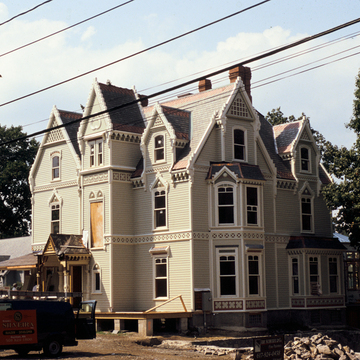The rising terrain south of Newton Center offered especially attractive land for large residential estates in the last quarter of the nineteenth century. Sargent Street between Waverly and Centre streets contains a particularly interesting variety of large houses, many still retaining their original spacious lots. Charles Haskell built one of the most extraordinary houses, at 27 Sargent Street (1879, NR), a vertical composition remarkable for the application of wood ornamentation, which resembles frosting on a cake. George F. Meacham may have designed this unorthodox house.
A block south of Sargent Street at 37 Park Avenue stands the Amos Adams House, a Queen Anne-style design by John A. Fox built in 1888 with multiple porches, turrets, and gable ends. Continuing west, Moffette and Tolman designed 140 Sargent Street, the J. Howard Nichols House (1878, NR), featuring multiple porches and gable ends in a picturesque treatment that is often called Stick Style. Although the front portion of this estate was subdivided for housing in the mid-twentieth century, the large open lawn extending down















